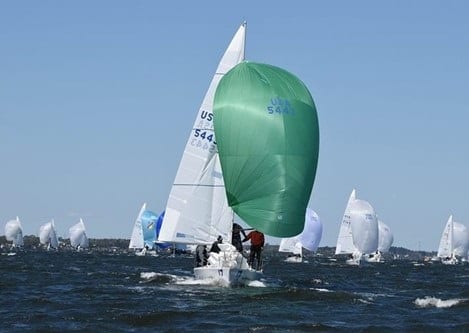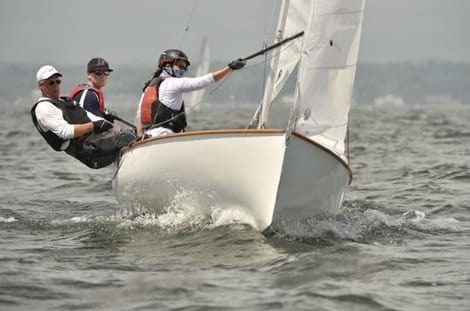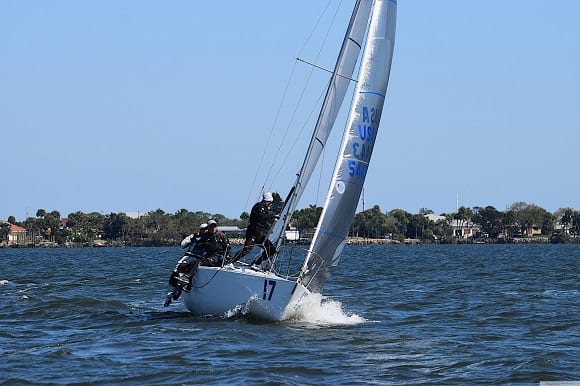By Dan Fien
You might be thinking, “I don’t need soft skills, I need to know how to make tactical calls like Tom Slingsby.” Well, the technical stuff is immensely important and getting the technical stuff practiced to the point where it becomes muscle memory is everything. However, the effectiveness of your practice and the rate that you learn from your racing experience is dependent on the attitude and methodology that you use when practicing.
Soft Skills
An underlying theme of this article is directed at being more deliberate with our learning process and communication. The goal is to reduce the number of times we need to re-learn a lesson. This does not have to supplant fun and all we need to get started is a notebook to keep a few lists of the things we identify to work on and practice. As we go through the list of soft skills, we will talk about specific things to keep in the notebook.
Race with a Team that has Similar Goals
The place to start being more deliberate with soft skill growth is by making sure the team we are sailing with is generally aligned with our own personal objectives. What are the primary reasons for you to sail? Write these in the front of your notebook. Ask your team members to do the same. At the next opportunity, discuss the reasons for sailing with the team and see if everyone is on the same page.
If we can establish that the team is interested in improving in most of the same ways you are, then they should be open to work on things that need practice with a bit more structure. These conversations are important and even though initially it may be hard to have them, the team should and will get good at having these discussions. They can be broad and encompass several seasons of goals or as narrow as a goal(s) for a single race. Work for collective agreement with the team as to what the goals are.
Defining Roles and Communication Paths
Develop a list of roles and define how communication will work between the roles. As an overview, the list might look like: Bow, Mast, Pit, Headsail Trimmer, Main Trimmer, Driver, Tactician, Boat Captain.
Every boat varies so do not get stuck with these. Examine each role and break down each one into the details of what they do around the course including off the water responsibility. Share your list with the team, listen to their input, and capture any changes. Defining/assigning these roles might seem obvious but it is critical to ongoing success and improvement of the team.
Now let us move on to the next level and clarify the communication pathway between roles. Set up a structure of who is talking to whom on the boat. The driver can really only listen to two or three people. Although the entire team has information to share, there needs to be structure as to how that information gets to the correct person without distracting the driver. Information sharing needs to be structured and practiced. Work and rework the details of communication. Communication on board is not always going to go well, and the task list along with the dialog process will evolve and improve. Lastly (this is big), go out and practice your dialog for every part of the race, make notes, elaborate in your list, and practice more.
Execution on the Course Starts with Unambiguous and Practiced Dialog
In addition to the lines of communication, we also need to work on what we say. All members of the team are most effective when they have the same expectations of what is happening and what is about to happen. For this reason, nothing can happen on the boat without clear dialog. So, it makes sense that we practice and codify what we say to enable the execution in every situation. Codifying dialog removes ambiguity. A good example of how effective and efficient codifying dialog can be is the role of “Human Speedo”. This particular role entails observing another boat on the course and describing our boat’s performance relative to it. One does this by observing Speed, (are you faster or slower), Range (are you sailing higher or lower) and VMG (integrating the two). If this dialog is arbitrary and unstructured, it can be very confusing. If we codify how we transmit this information, it can consistently be reduced to three words every time.
Here are the articulation rules for the “Human Speedo” –
- Always say the three parts in the same order: Speed, Range, VMG;
- Describe it in terms of our boat “we are faster,” never “they are slower”
- Use specific words:
- Speed will only be: Faster, Same, Slower;
- Range will be: Higher, Same, Lower,
- VMG will be: Better, Same, Worse.
This codification reduces all “Human Speedo” dialog to exactly three words.
The Tactician asks, “how are we doing against 5443 to leeward?”
The Human Speedo says, “Faster, Same, Better” or “Slower, Higher, Same.”
Done! Everyone knows exactly what is meant.
This is just one example of how the dialog for any and all aspects of a race can be codified, and as a result, enables clear, efficient unambiguous communication. Yes, this does take a lot of work and practice, but it has very broad and deep implications to success. It is as important to practice communication as boat handling for success. The dialog enables the execution. In your notebook, keep a list of any new dialogs that you define, and keep practicing them until they become automatic. The list will also come in handy when you review communication on board with new or guest crew.
Paint the Picture
‘Painting the picture’ is often a role for the tactician but not always.
Before we jump into what is “painting the picture” let us explain why this is such a big deal. I have one sentence that I believe defines what every crew member’s job is. It might actually be the “holy grail” for any crew. Ready:
The crew’s objective on any race boat is to minimize or eliminate everything that distracts the driver from driving.
A little elaboration: If the driver has 100% confidence that the rest of the team will put the boat in the right places on the course, headed in the right direction, and handle the boat around the marks, then what role is left for the driver? Drive fast!
The “paint the picture” role is to be the eyes outside of the boat for the driver. The dialog in this role depicts the race in real time and it is not JUST for the driver. It also keeps the entire team in the game so that everyone has confidence in and can anticipate what is happening on the course.
Let us look closer at the three elements of “painting the picture.”
- What is taking place contains? –
- What are the wind and wave conditions up the course?
- What does the fleet look like on the course?
- Where are we relative to the fleet / on the course?
- What are the near-buy situations that we may need to respond to
2. What is the next move? –
- This can be an entire article, but we can articulate this clearly using what we call: “If, Then.” statements
3. How does that fit our strategy? –
- Are we on our plan, or is the plan changing? And why.
Here is an example what this sounds like:
What’s taking place?
“We are 30% up the leg, just left of center in a right phase, pressure is even to the mark.
12 boats are to our left, two boats in the left corner are tacked, we are beating them, the six boats on the right do not look good.
What is the next move?
“If we start to get a header, then we will tack when ready to stay in phase. If the two-boat next to us tack before the shift we will not tack.”
How does it fit our strategy?
“We are softly protecting the left side of the course which is winning and was the plan.”
Nearby issues:
“We are trimmed in a couple clicks on the main and driving a little high to hold this lane.”
A key to being a good picture painter is to realize if you stop painting, the driver will start looking. So, if we cannot stop, DO NOT tempt the driver to look around. There are exceptions to this process, especially during the Start and at the Marks where painting the picture is not a good strategy. But for on-the-leg we really want the drive singularly focused on making the boat go fast.
The Mental Game
In this section, we are going to look at three fundamental tools:
- No one gets it all right; immediate recovery is part of the game,
- How to release the stuff that did not work but not lose the chance to learn from it.
- When you are on the water, you are racing.
In sailboat racing we are making decisions constantly, while mother nature and the fleet are continuously changing the circumstances. The expectation that you are going to get it right all the time will foster frustration and is not attainable. It is tough to put a number on the correct decision percentage in sailing but generally, if you are getting it right 75% of the time, you’re doing very well (meaning national titles). Therefore, at best, we are wrong 25% of the time. How are we going to handle those wrong decisions? We need to develop the ability to thrive through our mistakes with the same enthusiasm we do our success. Additionally, when we realize that the last move did not help us, every millisecond we spend thinking/talking about what just happened is delaying the time we start working on making the next decision. We just had a bad one. The next three are likely good, so let us move on to those!
The best way to “move on” is to know that a call that did not work is going to get reviewed later. You say, “please ask me about that call after the race”. Done, nothing else needs to be said. The team knows there is a time for addressing that call/move and it is NOT now. When we get off the water we MUST consistently debrief and identify the dialog needed to correct and eliminate the wrong call that happened.
Lastly on the mental game, good habits are helpful so when on the water, we are all in race mode whether on the way to the course, between races, or a practice day. Our intent is to establish a level of attention and effort that is habitual. This does not mean we are not having fun; we are just attentive and engaged.

Managing Emotion
One of the great aspects of using dialog to initiate execution is that it eliminates fault/blame from being aimed at an individual and puts it squarely on the dialog that did or did not happen. When a race situation goes badly, we get off the water and discuss “what did we miss,” or “how did we not anticipate that.” Once we identify what we missed, we create a dialog that forces us not to miss it again. Here is an example: One of the more critical decisions in a race is getting onto the proper jibe after rounding the top marks. This decision often happens on the offset leg or, even worse, after rounding the offset which is too late and can result in a screaming mess. So instead, find a trigger at the top of the weather leg, (always at 10 boat length or my favorite: when tactician turns over control of the boat to the driver to go around) and we include the spinnaker set plan at that time, every time. The goal is to have planned ahead for everything that we can, saving our patience for when we really need it, on unexpected issues.
The last thing to say about managing emotion is to think about how people perform when over-stressed. This normally raises the emotion during a difficult situation and causes people to make more mistakes. It is better to trust that the issue is understood and being resolved at the best pace possible. This is also the best way for the team to learn. As mentioned in the mental game, every millisecond we spend thinking / talking / screaming about what happened is impeding our effort to get on to that next decision.
If there are difficult things to review, we must take it off the water. Failing to do a post-race debrief is choosing not to get better and eliminates the opportunity for the team to voice their successes and concerns. The only bad race is one we fail to get better from.
Leadership
As crew, being a good leader is important, regardless of the assigned role. The team’s objective is to take full advantage of every talent on the boat. But, we cannot have everyone articulating their thoughts about the race at the same time. Setting up relationships and efficient lines of communication between members of the crew that extracts the knowledge and experience of each crew member is at the heart of team success. This communication pattern and the words used to convey information on board and around the course is definable and practicable. Any crew member can be the leader for managing this process.
Let us not sugarcoat how to become a great crew. Winning gets you noticed, winning with more than one driver/team makes you sought after. Methodically develop an immense set of skills that enable you to keep your driver focused on driving and you will be successful. Be rigorous, take it one step at a time, and stay on the learning path. Enjoy the journey!
Please visit One Design Central for more one design sailing resources and information.
About the Author:
Dan Fien represents North Sails in Upstate New York, where he is active in a broad range of one design and keelboat racing and coaching. As a tactician in the Thistle class, Fien has won three National Championships and six podium finishes total with three different skippers. He also holds a Master’s License from the U.S. Coast Guard.


